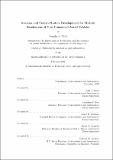Avionics and control system development for mid-air rendezvous of two unmanned aerial vehicles
Author(s)
Park, Sanghyuk, 1973-
DownloadFull printable version (2.992Mb)
Other Contributors
Massachusetts Institute of Technology. Dept. of Aeronautics and Astronautics.
Advisor
John J. Deyst, Jonathan P. How, James D. Paduano and Brent D. Appleby.
Terms of use
Metadata
Show full item recordAbstract
A flight control system was developed to achieve mid-air rendezvous of two unmanned aerial vehicles (UAVs) as a part of the Parent Child Unmanned Aerial Vehicle (PCUAV) project at MIT and the Draper Laboratory. A lateral guidance logic was developed for tightly tracking a desired flight path. The guidance logic is derived from geometric and kinematic properties, and has been demonstrated to work better than the conventional aircraft guidance method in waypoint navigation. A simple, low-order attitude estimation was developed that combines aircraft kinematics, GPS and low-quality rate gyros. It is demonstrated in simulation that the performance of the proposed method is as good as other advanced complex methods when the aircraft bank angle is relative small(<40 degrees). The end-game control strategy for the final phase of the rendezvous was also developed, using proportional navigation guidance in conjunction with an optical sensor. The associated miss distance was analyzed with regard to the wind effect and initial conditions. A series of flight tests was performed using two UAVs which were built as a part of the project. It was demonstrated that each individual aircraft can follow a desired flight path within a position accuracy of 2 meters (based on sensor data) while also tracking the air speed command to within 1 m/s. At the time of this thesis writing, it has been demonstrated that the developed control system can bring the two UAVs from any arbitrary initial positions into a configuration of a tight formation flight, where one vehicle trails the other with a commanded separation of 12 meters while maintaining the relative position error within 2 meters in both horizontal and vertical directions for 85% of the flight time.
Description
Thesis (Ph. D.)--Massachusetts Institute of Technology, Dept. of Aeronautics and Astronautics, 2004. Includes bibliographical references (p. 177-181). This electronic version was submitted by the student author. The certified thesis is available in the Institute Archives and Special Collections.
Date issued
2004Department
Massachusetts Institute of Technology. Department of Aeronautics and AstronauticsPublisher
Massachusetts Institute of Technology
Keywords
Aeronautics and Astronautics.